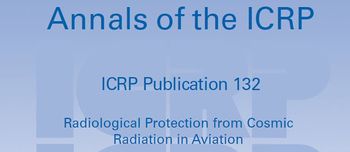Cosmic Radiation in Aviation
Radiation is a natural part of our environment.
|
What is “cosmic” radiation?
We are protected from cosmic radiation by Earth’s magnetic field and atmosphere. At higher altitudes in an airplane and particularly when closer to the North and South poles, this protection is less. During a commercial flight, cosmic radiation is several times higher than on the ground. What do experts recommend? More of us are travelling by air. Aircraft are constantly improving, allowing longer flights, at higher altitudes, and over the North and South poles. For most people, experts recommend no special measures. Information should be provided to those interested so they can be properly informed. People who fly very frequently, such as business people travelling long distances every week, may be interested in learning more. For example, it is possible to track your own cosmic radiation dose. It’s easy to do with on-line tools*. For air crew, like flight attendants and pilots, airlines should educate and inform employees about the doses and effects of cosmic radiation. Airlines should also assess and log these doses, making each employee’s personal dose information available to them. Provisions should be in place to adjust duties for air crew who have declared a pregnancy, if needed. National authorities and airline companies should raise awareness about cosmic radiation, and offer their support to make informed decisions about cosmic radiation exposure in relation to flying. |
 ICRP Publication 132 Radiological Protection from Cosmic Radiation in Aviation |
* One on-line tool for assessing cosmic radiation dose from flying is SIEVERT, developed by IRSN. This link is provided for information only.
Quotes from ICRP Publications
Publication 132 paragraph 27
... the range of average annual effective dose for aircraft crew is of the order of a few mSv (1.2–5 mSv depending on the flight routes offered by the airlines in a country), with a maximum value of approximately 6–7 mSv. The average annual effective dose is highly dependent on the average annual flight time, and is of the order of 600 h in European countries and 900 h in the USA. ...
Publication 132 paragraph 35
... epidemiological data show no clear relationship between the duration of work of aircraft crew, their corresponding doses from cosmic radiation, and an excess risk of radiation-related cancers ...
Publication 132 paragraph 61
... for the sake of transparency and applying the ‘right to know’ principle, the Commission recommends that general information about cosmic radiation be made available for all passengers, and encourages national authorities, airline companies, consumer unions, and travel agencies to disseminate general information about cosmic radiation associated with aviation ...
Publication 132 paragraph 60
... dose from cosmic radiation received by occasional flyers is sufficiently low that there is no need to warrant the introduction of protection measures.
Publication 132 paragraph 62 and 63
... frequent flyers [should] be treated in the same way as occasional flyers ... the Commission encourages frequent flyers who may be concerned about their exposure to cosmic radiation to assess their personal exposure using freely available dose calculators, in order to be aware of their exposure and adapt their flight frequency if they feel the need.
Publication 132 paragraph 65
... airline management [should] inform concerned aircraft crew about radiation and cosmic exposure ... in line with other safety issues ...
Publication 132 paragraph 66
... aircraft crew doses [should] be recorded, and ... annual and cumulative individual doses [should] be made available on request from the individual ...